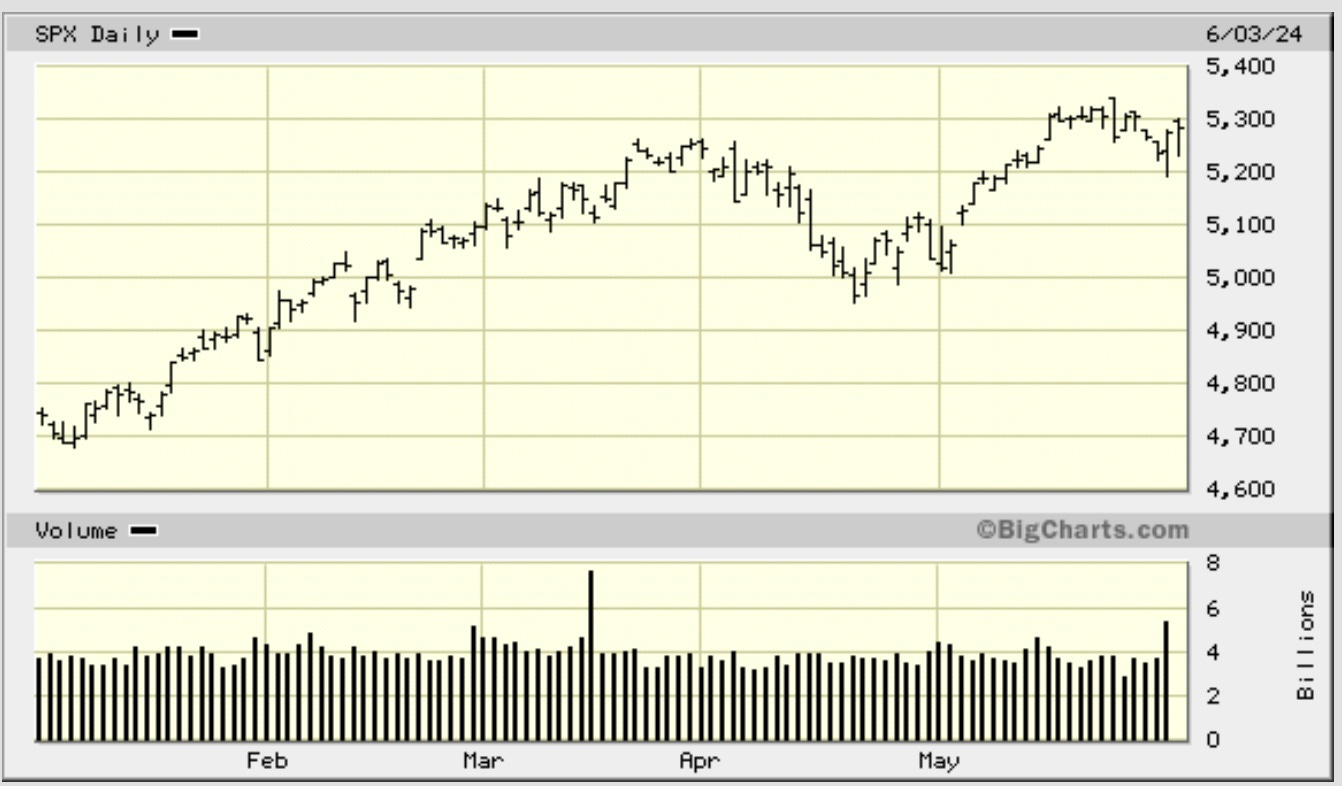
The market continues to round off from what now looks like a “classic double top.”
That looks something like this:

While I don’t put much faith in patterns like that as predicting a big crash is coming—because I’ve seen plenty of times when the market looked like that and then just went on up—some do see it that way, and I have plenty of other indicators I’m seeing that say the market is shifting now to realign with the reality of continuing inflation, continuing high interest and a declining economy. Some call it “stagflation.”
Fed Chair Jerome Powell does not call it that because he said he cannot see either the stagnant economy or the rising inflation. ”I don’t see the stag or the flation,” he said. I’m not sure how he can miss either of those, but somehow he does, and the rest of us are supposed to be comforted by his near-sightedness just as we were supposed to be when Ben Bernanke couldn’t see the recession he was standing in.
The economic clouds that the market was said to be troubled by today were weak US manufacturing data, which I’ve pointed out several times here in recent months, and which just delivered another bad outlook from the Institute for Supply Management’s manufacturing report. Energy, industrials and materials sectors particularly closed in the red, weighing more heavily on the Dow than on the S&P or the Nasdaq, which both nudged upward.
You can feel the change in the economy now
The air feels different now than it did a few months back when false hopes continued unabashed. Unsurprisingly, the ISM came in recessionary just like the Chicago Fed Survey and the Dallas Fed Survey that I reported last week. It hit the barometer at 48.9 when anything below 50 indicates a storm is coming in. (At least if you get a series of those readings, and we now have a series.)
“With technicals still stretched, [a] little fear baked in, and sentiment looking optimistic, we’re sticking with our call for volatility to pick up over the summer,” Wolfe Research chief investment strategist Chris Senyek wrote Monday.
I expect a stormy summer, too.
Investors appear to want some economic slowing that would give the Federal Reserve the greenlight to cut interest rates, but not too much of a slowdown that would raise fears of a recession.
Are you sure? If they wanted only a little economic slowing, this was the Goldilocks report that would have given that to them—showing just a little slowdown.
The purchasing managers group’s measure of new orders slid 3.7 points, the biggest drop since June 2022, to 45.4 in May. The bookings index now stands at the lowest level in a year, suggesting demand across the economy is weakening. As a result, ISM’s production index slipped to 50.2.
The last number is still slightly positive, though, and the other number is only the biggest drop in two years, which doesn’t go back far. With some measures down a little and one still positive, that’s as Goldilocks as it gets for an economy that slows enough to open the Fed to cutting rates without slowing enough to crash. Stocks should have gone up.
So, I think the downcast mood reflects unease over whether or not this is it for the economy—as in what we’re slowing down into could be worse than the Fed’s wishful soft landing. Not because it was a terrible report but because the numbers keep coming in this way in various reports now. I think it may also reflect that investors are no longer so sure that a minor slowdown will bring a Fed rate cut anytime soon, so minor may not stay minor as it will have no brakes to arrest it.
“I think we plateaued,” Fiore said on a call with reporters. “Without some kind of movement on the monetary side here, we’re probably sitting where we’re going to sit for quite some time.”
And that some time could be quite a long time because inflation is holding the Fed in place.
I can’t say any of that about the market’s reasons with any certainty because who reads the market’s manifold minds? However, the fact that the Dow fell 100 points with a single slightly recessionary report today says to me the market may be concerned that this is the third recessionary report in a week. The economic climate might be creeping toward a “be careful what you wish for” event.
Still, the most frequently and continually disappointed hope for over a year does not die hard. The big marketeers are still pounding that Fed-pivot/rate-cut hope, even though they’ve whittled it back all the way from expecting six cuts last year to now expecting only one. Even the best hopes are getting thin, but some are staying at it:
Markets are more wary of interest rates staying elevated than necessary, according to UBS.
Mark Haefele, CIO of the firm’s global wealth management division, said the market is now only anticipating 35 basis points of rate cuts in 2024. Meanwhile, he said the UBS base case is 50 points.
“Markets have become too cautious on the potential for easing this year, in our view,” he told clients.
(And you don’t hear them using the word “pivot” anymore because they wore that term, expressing the false promise of a hard, snap turn, down to its decaying roots.)
I think Zero Hedge got the market’s reading of the weather right:
After a very ugly, and quite stagflationary Mfg ISM print, which printed below the lowest estimate (and just as ugly Construction Spending print to boot), the hard landing trade re-emerged, and “bad news was once again bad news….”
The estimates by economists, who apparently buy their glasses from the same optometrist Jerome Powell uses, were simply too optimistic. They had every reason to expect some decline, and this wasn’t a lot, but they hoped for something closer to the neutral 50 zone, and that didn’t happen.
Torres continued, “In recent months, investors have cheered weaker-than-estimated data based on expectations that it could accelerate the start of the Fed’s policy loosening. Investors are now reacting to soft data with fear.“
And why would that be, except as I just wrote above, they are realizing that their one remaining hope of a single rate cut may now be blowing away because inflation is no longer yielding to the Fed, and declining economic data are stacking deeper in the meantime? It’s not that most people in the market get it, but maybe it is starting to sink into some enough to slowly tap off some of the market’s irrational enthusiasm.
I wouldn’t be too convinced of such wisdom, though, because this market has shown itself to be the most irrationally exuberant market I’ve ever seen, willing to ignore everything but what it wants to hear.
Something dark this way comes
This is that feeling you get before a summer storm—that something is changing in the weather. You’ve been reading about it here from some time, but I think investors in the market are now starting to become aware of it like livestock out in a field, growing uneasy because, as ZH writes,
Something odd is going on: as The Market Ear flagged earlier, lately the Nasdaq has moved in the opposite direction of the US 10 year, which is unexpected since tech loves falling rates, prompting the traders to conclude that “something is changing.”
Exactly. And what is it?
ZH’s view (and mine) is that …
Maybe stagflation fears are becoming concerning for Wall Street…
Not everyone sees it, of course, but the herd is getting restless.
The ISM survey showed new orders declining at their fastest rate since Dec 2023 and Prices Paid down a smidge but well above the last 18 months levels
You can feel the wind coming down like the cold sweep that precedes a storm. It’s not much movement, but it feels like the economy is cooling now—that it continues to shrink even as inflation seems intent to keep hanging around, holding the Fed’s help at bay. The skies are darkening. The storm clouds are gathering. The air pressure is changing enough that the animals can feel it.
The Market Ear is correct. Something beneath the surface of the market is shifting.
Something wicked this way comes.
Views: 201